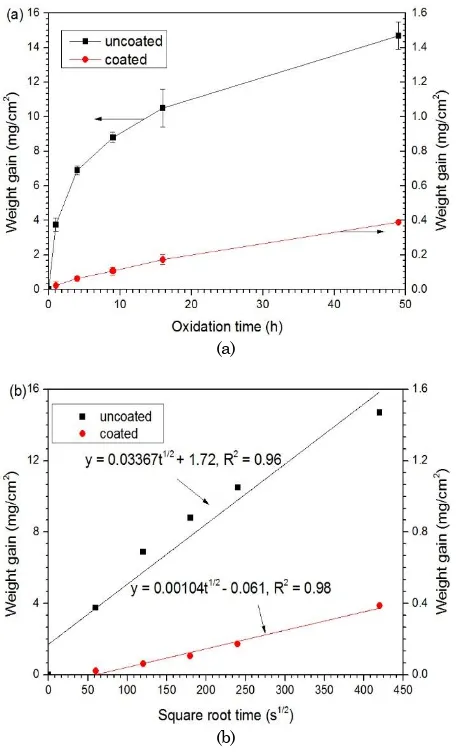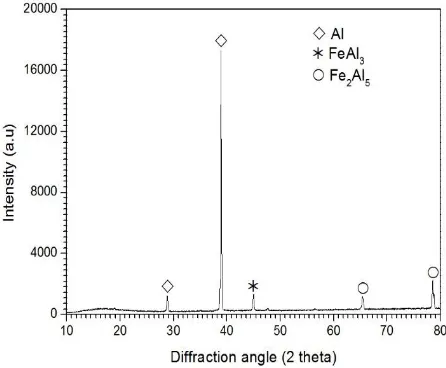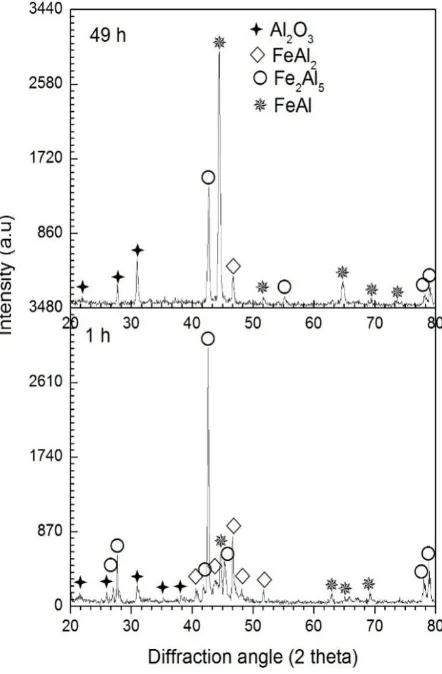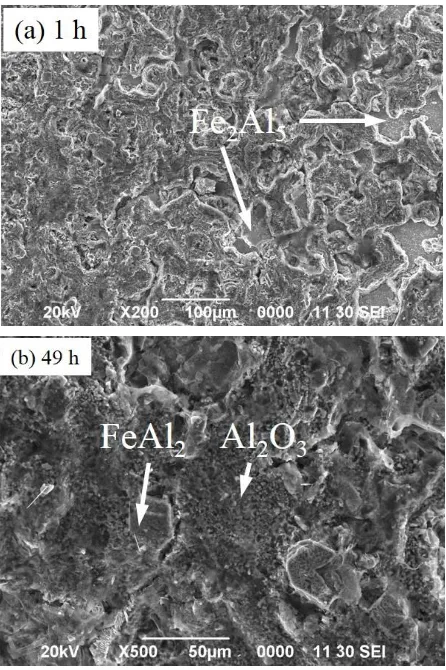Isothermal Oxidation Behavior of Aluminized AISI 1020 Steel at the
Temperature of 700
C
Mohammad Badaruddin1*, Suharno2, Hanif Ari Wijaya1
1 Mechanical Engineering Department, Engineering Faculty, Lampung University 2 Engineering Geophysics Department, Engineering Faculty, Lampung University
Jalan Prof. S. Brojonegoro No.1 Bandar Lampung, 35145, Indonesia *E-mail:[email protected]
ABSTRACT
The AISI 1020 steel was coated by dipping it into the molten Al bath at 700 °C for 16s. The coating layer formed on the steel substrate is consisting of Al with a little Fe, FeAl3 and Fe2Al5
layers. The morphologies of the FeAl3 and Fe2Al5 layers are platelet and columnar structures,
respectively. The oxidation test was carried out isothermally at 700 °C for a various time of 149 h in static air. The oxidation behaviors of both of the bare steel and the aluminized steel were studied by the oxidation kinetics, surface morphologies and phase transformation after oxidation testing. The oxidation products were characterized using Optical Microscope (OM), Scanning Electron Microscopy with Electron Dispersive Spectroscopy (SEM/EDS) and X-ray diffraction analysis. The magnitude of the rate constant (kp) of the aluminized steel is two order lower than
the bare steel. The formations of intermetallic phases on the steel substrate for a shorter time are dominated by the interdiffusion between the inward diffusion of Al-atoms into the steel substrate and outward diffusion of Fe-atoms. The constituent phases in the aluminide layer compose of FeAl2, Fe2Al5 and FeAl. The formation of FeAl phase is controlled by the inward
diffusion of Fe- atoms into the Fe2Al5 phase. The improvement of the oxidation resistance of the
aluminized steel subjected to severe oxidation is due to the formation of protective Al2O3 scale.
Keywords: Aluminized AISI 1020 steel, oxidation kinetics, intermetallic phase, Al2O3.
ABSTRAK
Baja AISI 1020 dilapisi dengan mencelupkan ke dalam bak Al cair pada temperature 700 °C selama 16 detik. Lapisan yang terbentuk pada pada permukaan baja adalah Al dengan sedikit Fe, lapisan FeAl3 dan Fe2Al5. Morfologi lapisan FeAl3 adalah struktur datar dan Fe2Al5 adalah struktur kolumnar. Uji oksidasi dilakukan secara isothermal pada temperatur 700 °C selama1sampai 49 jam dengan kondisi udara statis. Perilaku oksidasi baja tanpa pelapis dan baja lapis Al dipelajari melalui kinetika oksidasi, morfologi permukaan dan transformasi fasa setelah pengujian oksidasi. Hasil-hasil oksidasi dikarakterisasi menggunakan mikroskop optik, SEM, EDS dan XRD. Besarnya laju constanta parabolic (kp) baja lapis Al lebih rendah dua digit pangkat dibandingkan baja tanpa lapis Al. Pembentukan fasa intermetalik pada substrat baja untuk waktu oksidasi 1 sampai 9 jam didominasi oleh interdifusi antara difusi atom-atom Al ke dalam substrat baja dan difusi atom-atom Fe ke dalam lapisan intermetalik. Lapisan intermetalik yang terbentuk pada substrat baja adalah Fe2Al5, FeAl2 dan FeAl. Pembentukan fasa FeAl dikontrol oleh difusi atom-atom Fe ke dalam fasa Fe2Al5. Peningkatan ketahanan oksidasi baja lapis Al pada temperatur 700 °C dikarenakan pembentukan lapisan pelindung Al2O3.
Kata kunci: Baja lapis Al, kinetika oksidasi, fasa intermetalik, Al2O3.
INTRODUCTION
Low carbon steel, AISI 1020, is relatively low price and its corrosion resistance at high tempera-tures can be increased by hot-dip aluminizing coating method. This steel can be manufactured for engineering components such as pressure vessels, boiler, gas or oil pipelines. Hot-dip aluminum coating
method was chosen because this method is cheap and able to be mass produced for a large component, with complex and asymmetric shapes.
Due to a high concentration of corrosive gases, such as those in Ulubelu geothermal production field at Lampung Province, the design process of pipe line for steam production in geothermal wells should be given special attention againts corrosion resistance and strength of the materials to prevent catastrophic failure during operation when the line is filled with oil or steam [4]. An application of protective coating, such as hot-dip Al coating can suitably be used on the pipe to replace the use of stainless steel or titanium pipe [5]. Using this technique the produc-tion and maintenance cost can be minimazed.
The present work focuses on the investigation of high-temperature oxidation of low carbon steel with aluminized coating at 700°C. This temperature represents the high limit of temperature that may be experienced by a steel pipe in high temperature condition. Reaction rates, morphology of reaction products, and composition changes occurring in the aluminized steel, are examined to provide an insight into the oxidation mechanisms.
EXPERIMENTAL PROCEDURE
The substrates were cut into coupons with the sizes of 20 mm × 10 mm × 1 mm from the commercial AISI 1020 steel with composition (wt.%); 0.2C – 0.5 Mn – 0.04P –0.05S and Fe–balance. Before hot dip aluminizing was taken all specimens were cleaned by 5% NaOH and 10% H3PO4, and
then coated by uniform Al welding flux. The Al ingot with 99.9 wt.% was melted in an alumina crucible
In order to investigate the oxidation behavior of the bare and the aluminized steel, all specimens were exposed in a box furnace at 700 °C for 49 hours. After a given isothermal oxidation time, the speci-mens were taken out and cooled in air at room temperature. Each weight gain data point for the oxidation kinetics was obtained from a different specimen. Only aluminized specimens were charac-terized as following; structures of scale and phases formation were identified by X-ray diffraction (XRD) using monochromatic Cu-Kα,the cross-sectional micrograph was taken by optical microscope (OM), the surface morphology and cross-sections of the specimens and chemical composition (at.%) were examined using scanning electron microscopy (SEM) with secondary electron image (SEI) signals and oxidation kinetics curve is shown in Figure 1. Figure 1a shows changes in weight gain per unit surface area versus time, revealing that the kinetics curves approximately obeyed the parabolic rate law. In addition, it can be seen that the weight gain of specimens increases with increasing temperature. At the oxidation time approximately 8 h, the oxidation rate increases rapidly. In this stage, the oxidetion rate is controlled by the oxygen/metal reaction. Whereas, after oxidation time of 8 hours, the oxida-tion rate of coated specimen increases gradually, indicating that the Al-rich oxide scales formed on the surfaces can act as a diffusion barrier. However, the aluminized steel has a lower weight gain than that in bare steel. The bare steel shows a high oxidation rate in increasing of weight gains, indicating that the AISI 1020 steel cannot withstand oxidation attack at 700 °C for 49 h in air environment.
(a)
(b)
The aluminized steel shows much improved oxidation resistance. The alumina decoating exhibits excellent high temperature oxidation protection due to the formation of aprotective alumina scale (Al2O3).
After being oxidized for 49 h, the weight gain of the coated specimen is approximately 0.388 mg/cm2, only
about 1/38 of the uncoated specimen (14.69 mg/cm2).
The kinetics rate, kp, was calculated from Figure 1b,
using the equation of W= kpt1/2, whereW is the
weight gain per unit are and t is the oxidation time. The kinetics rates of the bare and the aluminized steel are approximately 8.456 × 1010 and 1.073
1012 g2 cm4 s1, respectively. The kp value of the
aluminized steel in this study is almost similar to the previous work [6]. The formation of protective Al2O3
layer takes place to control the diffusion reaction of outward Al- cations and inward O- anions through the oxide. Therefore, the kinetics rate is decreased very significantly.
Microstructures and XRD Examinations
Figure 2 shows mainly two coating layers; one is Al-layer with poor Fe, and the others is inter-metallic layer consisting of FeAl3 and Fe2Al5 layer.
The XRD pattern is shown in Figure 2 for the coated sample. This sample, after the hot-dipping step, was lightly centrifuged so as to remove as much alumi-num from its surface as possible. The purpose was to be able to reach the intermetallic layer with minimal grinding. In these XRD patterns, the diffraction peaks from aluminum (FCC) and intermetallic com-pounds have been marked with suitable symbols.
It can also be observed that the phase of FeAl3
formed between Al matrix and Fe2Al5 phase shows
the plate structure, while the morphology such as the tongue-like can be seen clearly onthe phase of Fe2Al5. This morphology is generally found on the
hot-dip aluminized steel with an approximately 99.9 wt% Al (pure Al). The uniform thickness of Al layer and the intermetallic layer are approximately 10m in outermost and approximately 50m in inner most, respectively. The aluminized layer seems to be homogenous and good adherence to the steel substrate. No pores and crack can be seen, which is common in the Al- diffusion coating formed after hot-dipping process. The composition of FeAl3 and Fe2Al5
are about 80.02Al−19.8Fe and 69.29Al−30.691Fe
(at.%), respectively. Besides that, the tongue-like morphology is associated with vacancy defects owned by Fe2Al5 phase about 30% and therefore, Al can
diffuse more rapidly into the steel substrate than the outward diffusion of Fe atom during immersion of steel into a molten Al bath. In addition, these vacancies provide easy diffusion paths in the c direction, contributing to the rapid growth of the Fe2Al5 phase[7]. This phase growth is controlled by
temperature, where the diffusion coefficient of Al
atom is higher in solid Fe;53 × 104 m2s1at the
temperature range of 520650 °C, and the diffusion coefficient of the iron atom (Fe); 1.8 × 10-4 m2s1 at
the temperature range of 8301400 °C [8,9].
In order to understand the oxidation behavior and the phases formation of the aluminized steel, the oxidation test was carried out at 700 C in static air for various durations of time. For 1 hour oxidation at 700 C as shown in Figure 4, the aluminum topcoat could not be observed again in the coating layer. The aluminum topcoat disappeared and an aluminide layer formed owing to the outward diffusion of iron from the matrix and to the inward diffusion of aluminum. The aluminide layer being approxima-tely 60 μm thick consists of a very thin Al2O3 layer
on the surface, followed by a thicker layer of Fe2Al5 +
FeAl2 on the steel substrate side. However, the
columnar morphology of Fe2Al5 (tongue-like
morpho-logy) can be still observed on the steel substrate.
Figure 2. BEI of Cross-sectional Micrograph of the Hot-dip Aluminized AISI 1020 Steel
Figure 4. Optical Microscopies of Cross-sectional Micro-graps of the Aluminized AISI 1020 Steel Oxidized at 700 °C for Various Duration of Time.
According to Figure 5, X-ray diffraction results confirm that there are three layers of intermetallic layer formed e.i Fe2Al5, FeAl2 and FeAl
correspond-ing to the high intensity peaksafter the aluminized steel was oxidized at 700 °C. But a low intensity peaks for Al2O3 was found fora sample oxidized for 1
hours. For 9 hours oxidation time, some voids formed in the aluminide layer as a result of phase trans-pormation, well known as Kirkendall effect [10]. Vacancies generated by inter diffusion between Al atoms and Fe atoms during phase transpormation in the aluminide layer condensed into voids. As shown in Figure 4, the black area in the aluminide layer was likely to be oxides formed from the specimen surface by high-temperature oxidation. In addition, for the oxidation time 9 hours, the columnar structure of Fe2Al5 phase can still be observed in the
aluminide layer, that indicates the rapid diffusion of Al atoms direction. Moreover, the thin FeAl layer is not clearly seen in the aluminide layer. The Fe2Al5 +
FeAl2 layer plays an important role as a reservoir of
Al consumption to protect the steel by formation of protective Al2O3 layer. Consequently, many
cavita-tions can be observed clearly, indicated as black area in outer part of aluminide layer as the oxidation time was increased to 16 hours.
During oxidizing process, the outward diffusion of Al forms Al2O3 scale, and the other is Al inward
diffusion toward the steel substrate. While the Fe inward diffusion into the Fe2Al5 + FeAl2layer leads to
formation of FeAl layer. The phase consists of approximately 45 at.% Al. After oxidation time was increased to 49 hours, the FeAl layer gradually thic-kened, as shown in Figure 4. The peak intensity
corresponding to the FeAl phase shows the highest value as shown in Figure 5. The aluminide layer thickness is relatively similar for all given oxidation time.
As shown in Figure 5, as the oxidation time was prolonged to 49 hours, the peak intensity for the Fe2Al5 decreased, whereas the peak intensityfor the
FeAl phase increased. One interesting about the formation of intermetallic layer during the oxide-tion process can also be observed that a cracks penetrate through the thickness of the aluminide layer when the oxidation timeruns around 9 hours (Figure 4). The thermal stresses induced into voids, lead to a crack generation in the aluminide layer [10]. After oxidation for 16 hours, the columnar structure of the Fe2Al5 phase was reduced and then
the second FeAl2 layer was formed between the layer
of Fe2Al5 and FeAl because the Al atoms diffused
outwardly from the Fe2Al5 phase. The inward
diffusion of Fe atoms from the steel substrate into the Fe2Al5 + FeAl2 layer generated the FeAl phase, is
shown in Figure4. For a longer oxidation time, the formation of FeAl phase seems that this phase formation is controlled by the inward diffusion of Fe atoms into the Fe2Al5 phase [11].
As mentioned above, the low rate of oxidation of the aluminized steel is due to the formation of a protective Al2O3 scale formed on the aluminide layer.
The Al2O3 scale on the aluminide layer during
oxi-dizing process takes a place as diffusion barrier. This layer blocks the diffusion of oxygen into the alumi-nide layer, therefore the very thin alumina layer (Al2O3) is formed on the aluminide layer and this
layer is very protective to protect the steel from severe oxidation attack during service at high tempe-rature. The availability of aluminum in the steel substrate is at least 5% in atomic composition to form a protective Al2O3 layer [12].
Meanwhile, through the top view investigation of scanning electron micrograph, it is clearly observ-ed that the aluminum oxide formobserv-ed on the coatobserv-ed specimen, as shown in Figure 6a. The formation of a protective layer was dominated by the phase inter-metallic Fe2Al5. But for a longer oxidation time,
forming a layer may be replaced by FeAl2 phase as
shown in Figure 6b. The SEM micrograph shown in
Figure 6 reveals the oxide morphology of the aluminized steel specimen after oxidation at 700 °C for 149 hours; the surface morphology of the oxide scale reveals dense character, which consists of Al2O3. More voids and pores are observed in the
aluminide layer.
Figure 6. SEM of Surface Morphologies of the Aluminized AISI 1020 Steel Subjected to Isothermal Oxidation at 700 °C.
CONCLUSSION
The kinetics rate of the AISI 1020 steel can be decreased very significantly by the hot-dip alumi-nizing coating. The improvement of high tempera-ture oxidation resistance of the aluminized steel is associated by the formation of protective Al2O3 scale.
Formation of FeAl intermetallic layerduring oxide-tion for a shorter oxidaoxide-tion time is dominated by interdiffusion between the outward diffusion of Al atom and the outward diffusion of Fe atom. Whereas, for a longer oxidation time the formation of FeAl phase is controlled by the diffusion of Fe atom into the Fe2Al5 phase. The formation of Al2O3 scale is Ministry of Research and Technology of Indonesian Republic via the incentive research of National Inovation System under contract No: 1.47/SEK/IRS/ PPK/I/2012.
REFERENCES
[1] Qiao, L. and Yan, L.H., Stress Corrosion Crack-ing of AISI 321 Stainless Steel in Acidic Chloride Solution, Mater. Sci., 25, 1998, pp. 4751. [2] Kalivodova, J., Baxter, D., Schutze, M., and
Rohr, V., Gaseous Corrosion of Alloys and Novel Coatings in Simulated Environments for Coal, Waste and Biomass Boilers, Mater. Corr., 56(12), 2005, pp. 882889.
[3] Erlindo, C., Angcoy, Jr., Archibald, L.A., Romeo, P.A., Garry, F.C., Melvin, D.L., Christine H.S. and Ruperto Jr. R.V., Mechanisms of Erosion-Corrosion in Well 311D, South Sambaloran, Leyte Geothermal Production Field, Proc. World Geothermal Congress, Bali, Indonesia, 2010. [4] Ghosh, S.J., Failure Analysis of a Jacking Oil
Pump, Fail. Anal. Prevent, 7, 2007, pp. 23–27. [5] Cédric, N.H., Factors Affecting Costs
Geother-mal Power Development, the GeotherGeother-mal Energy Association for the U.S. Department of Energy, 2005.
Tek-[8] Mc Kamey C.G., In: Stoloff, N.S. andSikka, V.K., Editors, Physical Metallurgy and Processing of Intermetallic Compounds, Chapman Hall, New York, 1996, p. 351.
[9] Neumann, G., in: Mehrer, H., Edition, Diffusion in Solid Metals and Alloys, Numerical Data and Functional Relationships in Science and Techno-logy, Springer, 261, 1999, p. 152.
[10]Chen, S.M.and Wang, C.J., The High-Tempera-ture Oxidation Behavior of Hot-Dipping Al–Si
Coating on Low Carbon Steel, Surf. Coat. Technol., 200, 2006, pp. 6601–6605.
[11]Kobayashi, S. and Yakou, T., Control of Inter-metallic Compound Layers at Interface Between Steel and Aluminum by Diffusion-Treatment, Mater. Sci. Eng. A, 338, 2002, pp. 4453.



